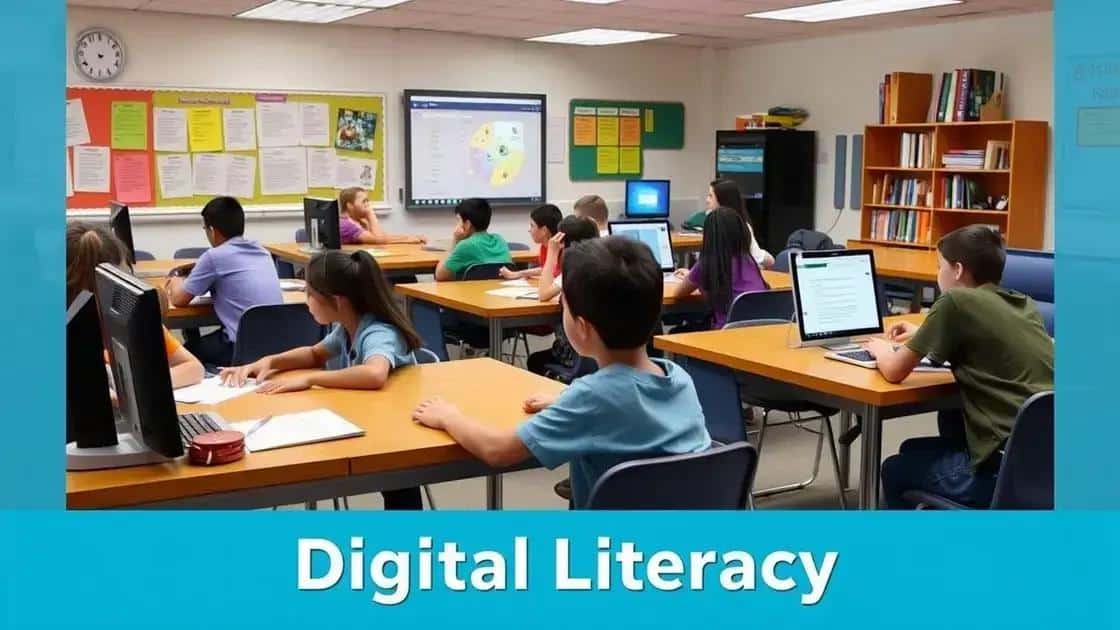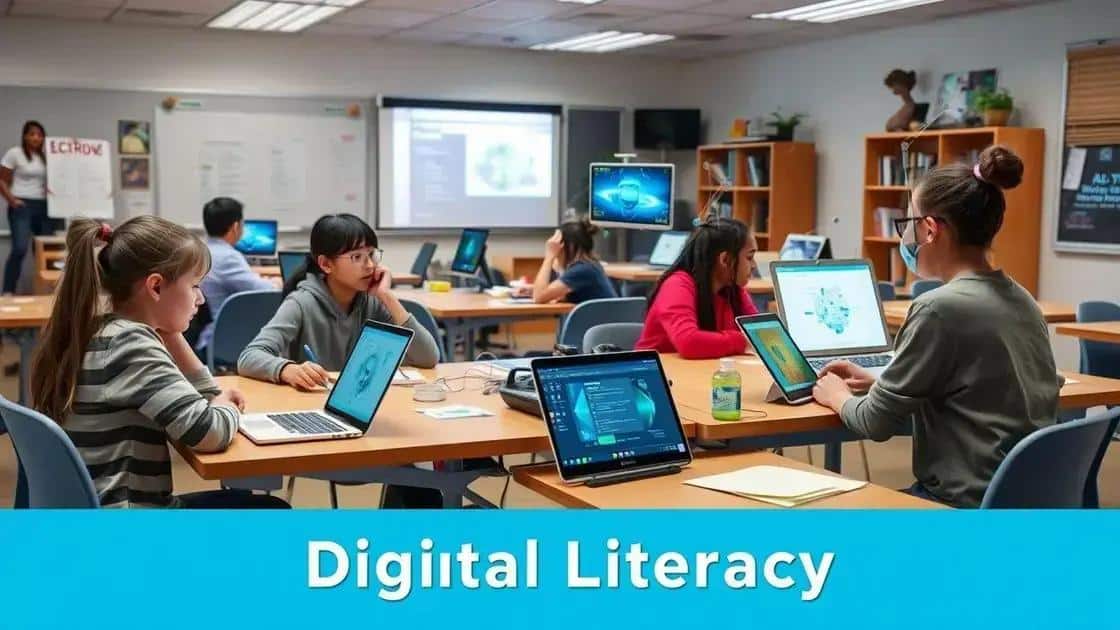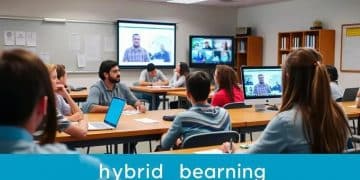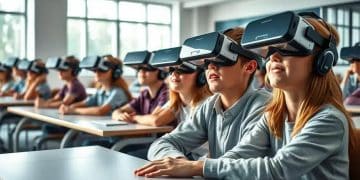Insights on digital literacy curriculum: why it matters

Digital literacy curriculum equips students with essential skills to navigate technology, fostering critical thinking, communication, and information evaluation necessary for success in a digital world.
Insights on digital literacy curriculum are increasingly crucial in today’s technology-driven world. Have you ever wondered how digital skills shape our students’ futures? Let’s dive deeper into its significance.
Understanding digital literacy frameworks
When we talk about digital literacy, understanding digital literacy frameworks is essential. These frameworks provide a roadmap for educators to design effective curricula that foster crucial skills in students.
Digital literacy includes various competencies that allow individuals to navigate the information age efficiently. As technology continues to evolve, it’s vital for educational frameworks to adapt accordingly.
The core components of digital literacy frameworks
These frameworks generally comprise several key areas:
- Information literacy: The ability to locate, evaluate, and use information effectively.
- Communication skills: Engaging in digital communication while understanding etiquette and ethics.
- Technical skills: Proficiency in using various digital tools and platforms.
- Critical thinking: Analyzing and evaluating digital content for credibility and relevance.
As we recognize these components, it becomes clear that a structured approach is necessary. Schools should emphasize these areas in their curricula. For instance, incorporating technology-based projects can enhance information literacy while fostering teamwork.
Furthermore, teachers can include lessons on communication skills through collaborative platforms and discussion boards. This practical experience helps students apply their digital literacy in real-world contexts.
Challenges in developing digital literacy frameworks
Implementing effective digital literacy frameworks isn’t without its challenges. Educators may face obstacles such as varying levels of technology access among students. Some may struggle with using digital tools effectively, which can hinder their learning opportunities.
To combat these challenges, schools must provide adequate resources and training for teachers. Ongoing professional development can help educators stay updated on emerging technologies and innovative teaching methods.
Ultimately, a strong emphasis on digital literacy within the education system equips students for success in an increasingly digital world. By understanding and implementing effective frameworks, teachers can better prepare their students to navigate the challenges of the information age.
Key components of an effective curriculum

To build an effective digital literacy curriculum, it’s important to identify its key components. These essential elements work together to enhance students’ skills and prepare them for the digital world.
One critical aspect is aligning curriculum goals with relevant standards. This alignment ensures that students acquire the necessary skills to thrive in a tech-oriented society. A curriculum must focus on both foundational knowledge and specific competencies.
Essential components of an effective curriculum
Here are some components that should be included:
- Curricular Goals: Clear and measurable objectives help in tracking students’ progress.
- Assessment Strategies: Utilize various formative and summative assessments to gauge understanding.
- Resource Allocation: Ensure access to the right tools and materials to facilitate learning.
- Engagement Techniques: Incorporate interactive and collaborative activities to motivate students.
By focusing on these components, educators can create a supportive learning environment. For instance, integrating multimedia resources enhances engagement by catering to different learning styles.
Another vital element is ongoing professional development for teachers. This training equips them with innovative teaching methods and keeps them updated with the latest technologies. By doing so, teachers remain effective in delivering the curriculum.
Incorporating real-world applications
To make the curriculum relevant, it’s crucial to incorporate real-world applications. Connecting lessons to everyday technology helps students see the value of their learning. For example, students can work on projects that require them to utilize online research skills.
Providing opportunities for students to collaborate on digital projects fosters communication and teamwork. This approach not only enhances their skills but also prepares them to work in diverse environments.
Ultimately, the key to an effective digital literacy curriculum lies in integrating these components seamlessly. By ensuring a holistic approach, educators can better prepare students for the evolving demands of the digital age.
Challenges in implementing digital literacy education
Implementing digital literacy education comes with its own set of challenges. Recognizing these obstacles is crucial for educators and institutions aiming to create effective learning environments.
One major challenge is the diverse range of technology access among students. Some students might have the latest devices and reliable internet, while others struggle with outdated technology or limited connectivity. This disparity can impact the effectiveness of digital literacy programs.
Key obstacles to consider
Several key challenges can hinder the implementation of digital literacy education:
- Resource Limitations: Many schools face budget constraints that limit the availability of necessary technology and training.
- Teacher Training: Educators may not have adequate training to effectively teach digital literacy skills.
- Curricular Integration: Difficulty integrating digital literacy into existing curricula can lead to fragmented instruction.
- Student Engagement: Keeping students motivated in a rapidly changing digital landscape is challenging.
Moreover, it’s important to address the gap in teacher proficiency with technology. If educators are not confident in their own digital skills, they may struggle to teach these competencies effectively. Providing comprehensive training for teachers can bridge this gap and empower them to foster a tech-savvy environment.
Another significant factor is the need for continuous curriculum updates. The digital world evolves quickly, and educational materials must keep pace. Schools should establish mechanisms for regularly reviewing and updating their digital literacy programs to ensure relevance and effectiveness.
Finally, ensuring that all students have equal access to digital tools is critical. Schools and communities must work together to provide resources, such as loaner devices or subsidized internet services. Addressing these challenges head-on can make a difference in how digital literacy education is implemented and sustained.
Future trends in digital literacy education

The future of digital literacy education promises exciting transformations. As technology continues to evolve, so must the strategies we use to educate students in digital skills.
One trend is the increased integration of artificial intelligence (AI) into the classroom. AI tools can provide personalized learning experiences, catering to individual students’ needs. Teachers can utilize these tools to assess performance and offer tailored resources to improve learning outcomes.
Emerging trends to watch
Several key trends are shaping the future of digital literacy:
- Blended Learning: Combining online and face-to-face instruction allows for flexible learning opportunities.
- Gamification: Using game-like elements in education can enhance student engagement and motivation.
- Collaborative Tools: Platforms that enable teamwork and project management foster essential communication skills.
- Focus on Cybersecurity: As digital threats grow, understanding online safety is increasingly important for all users.
Furthermore, the global shift toward remote learning has highlighted the need for strong digital communication skills. Students are learning to collaborate and share information across various digital platforms. This skills development will be crucial as the workforce evolves.
Another important aspect is the rise of digital citizenship education. Teaching students how to be responsible, ethical users of technology ensures they understand the implications of their online actions. Schools need to incorporate lessons on digital footprints and online behavior into their curricula.
Ultimately, the future of digital literacy education will focus on adaptability and continuous learning. As innovations emerge, educational strategies must reflect the demands of the digital landscape. By staying informed about trends and adapting curricula, educators can help students thrive in a rapidly changing world.
In conclusion, digital literacy education is essential for students in today’s tech-driven world. As we embrace new technologies and teaching methods, it’s crucial to adapt our curricula to meet the evolving needs of learners. By recognizing the challenges and implementing effective strategies, we can create inclusive learning environments that foster essential digital skills. The future holds exciting possibilities, and educators must stay informed and flexible to ensure the success of all students.
FAQ – Frequently Asked Questions about Digital Literacy Education
Why is digital literacy education important?
Digital literacy education equips students with essential skills to navigate technology and prepare for future careers in a digital world.
What are the main components of an effective digital literacy curriculum?
Key components include clear curricular goals, assessment strategies, resource allocation, and techniques to engage students.
What challenges do educators face in delivering digital literacy education?
Challenges include varying technology access among students, the need for teacher training, and difficulties in curriculum integration.
What future trends should we expect in digital literacy education?
Emerging trends include increased use of AI, blended learning approaches, gamification, and a focus on digital citizenship.





